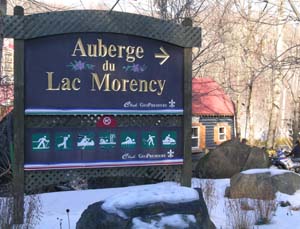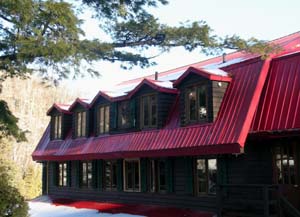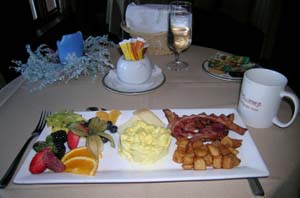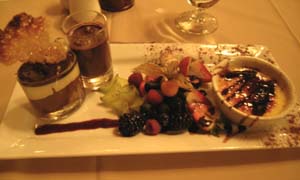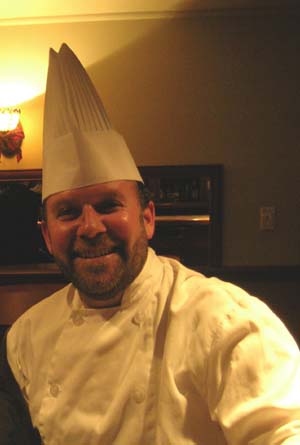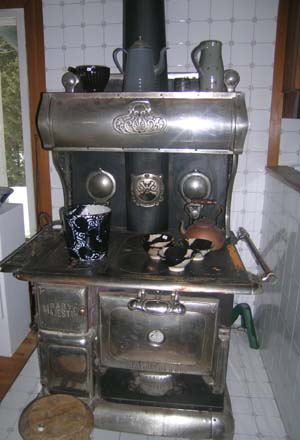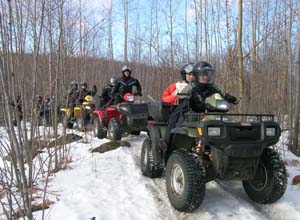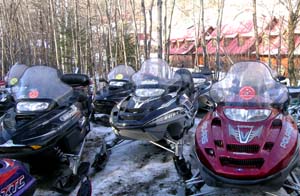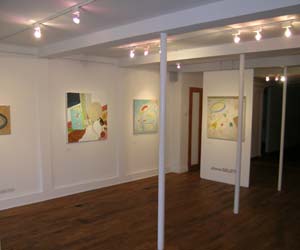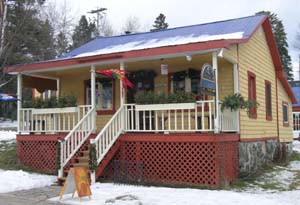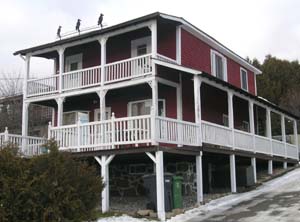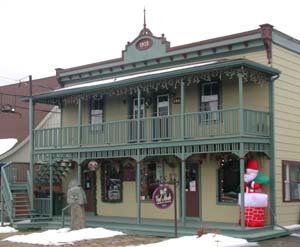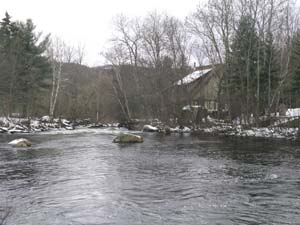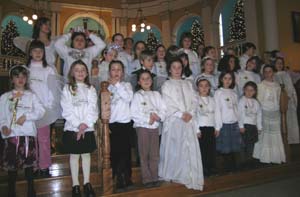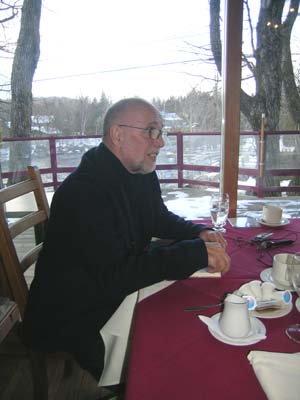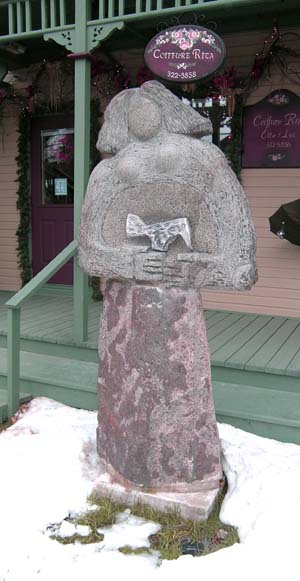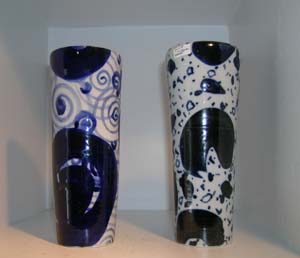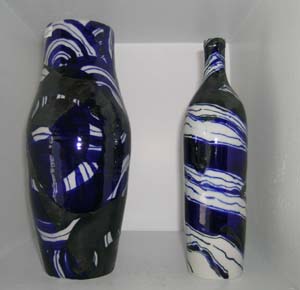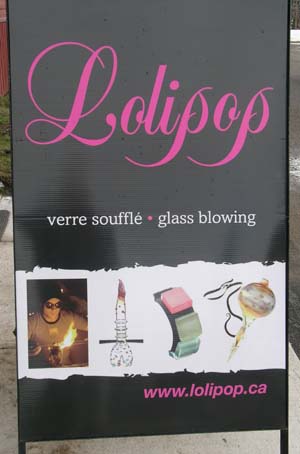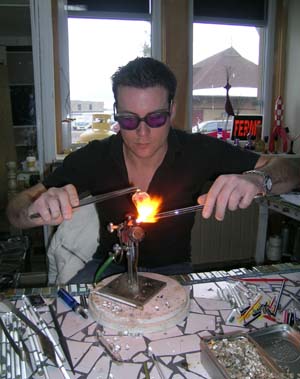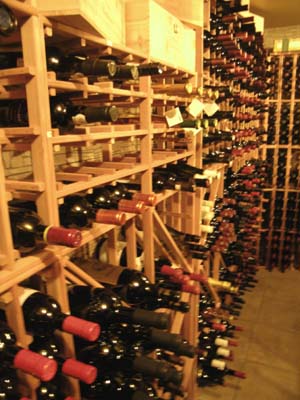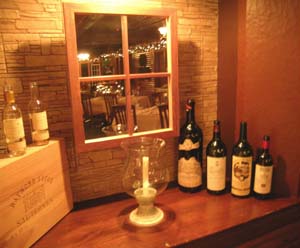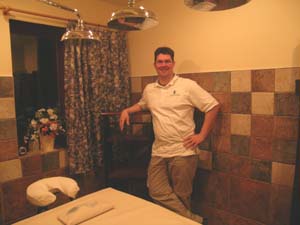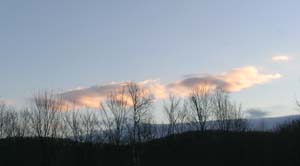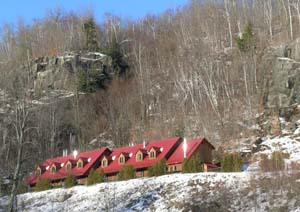| 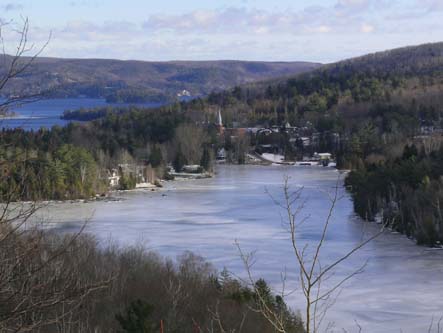
Songs of Winter
Winter in Québec is not
just a season. For the Québécois, it is a grand ritual,
an elaborate ceremony, and a state of mind. It is also the cultural
internalization of almost 400 years of struggling with — and
yet living in harmony with — the land. It is a source of a
collective sense of self and a a significant element in the self-determination
of this Canadian province which is distinct on so many levels.
Many of the artists of Québec
imbue their work with a healthy respect for this formidable season.
One of Québec's best-loved chansonniers (poet-singer-troubadours
... and often superstars) was Félix Leclerc. In his hymn
to winter, Soirs d'Hiver, (Winter Evenings) he
gives a glimpse of how winter has become part of the Québec
psyche.
Les soirs d'hiver, ma mere
chantait
Pour chasser le diable qui rit;
C'est a mon tour d'en faire autant
Quand sur mon toit coule le vent.
On winter evenings, my mother sang
To chase away the laughing devil;
Now it is my turn to do the same
Each time I hear the wind in the eves.
The beauty of winter in Québec's
Laurentians is not only in the splendour of a natural environment
that surpasses all expectations, but it is also in the interaction
of the people who have not forgotten the communal values and skills
that are their ways and means of physical and cultural survival.
The oft-repeated term joie
de vivre is indeed integral to the Québec way of life;
however, I always take that term one step further to l'art de
vivre.
Québec's Laurentian playground
— especially in the winter — is about community, and
the interdependence of human relationships. It is about survival
and la belle énergie that is the heartbeat of the
true human village.
A visit to
the Laurentians is “a moveable feast.” Allow me to offer
you a few appetizers.
Geology
and time have been good to the Laurentians
For travel journalists, the
way in which landscape shapes culture is a recurring theme and lesson.
Moreover, despite our well-founded concerns about an over-crowded
planet, we are fortunate now and again to discover (or re-discover)
areas of peace and tranquillity — and spaciousness.
In the Laurentians — 22,000
square kilometres of natural beauty — you will discover a
rugged landscape that, by its very nature, has preserved “the
natural order of things.” And this includes a pace and quality
of life that increasingly we see dissipating.
This is Le pays d'en haut.
As is often the case, the term defies a suitable translation. It
means something like “the land up there” or “the
highlands” or “away and beyond.” But the experience
of the Laurentians has always been a multi-levelled one; an experience
of something much deeper conceptually and — dare I say it
— spiritually.
The Laurentians contain 9000
lakes and rivers, three enormous and separate regions (the Laurentian
Gateway region within easy access to Montréal; the Laurentian
Heartland; and the Upper Laurentians), and an integrated network
of towns and villages, each of which has its own particular flavour
and idiosyncrasies. In my experience of visiting Québec for
over 40 years, this ease of self-expression is very typical of the
province, one of the most liberal and free-thinking “communities”
in North America. And the rigorous but permissive landscape and
topography of the Laurentians enhances this cultural trait.
These are very old mountains;
part of the famous (Precambrian) Canadian Shield. These are not
the soaring and grandiose mountains of the Canadian Rockies (upstarts
really); these are ancient mountains that have endured the ancient
and ceaseless grinding of glaciation, a monumental process that
eventually created a rather subdued topographical relief. This is
one of the oldest physical landscapes on the planet; and an environment
that nurtures a free spirit embellished by wisdom.
These ancient rocks are the
Earth unclad. Covered by a thin layer of soil, this is planetary
bedrock that was the first to be permanently elevated above the
sea. And the titanic geological forces that created this land, and
its many small lake basins and rivers, also left behind a boreal
forest that is home to abundant flora and fauna.
The Auberge
du Lac Morency: hospitality spoken here
As a guest at l'Auberge du Lac
Morency, I became an instant happy camper. I immediately felt chez
moi — as if I had refused to acquiesce to the maxim that
“you can't go home again.” You probably have experienced
a similar holistic feeling of familiarity and ease somewhere in
your travels.
The village-like comfort zone
of the Auberge is quite typical of the Laurentians. With one notable
exception, the Laurentians have succeeded in repelling the mega-corporate,
mega-resort mentality. And the human scale amenities and aesthetic
finesse of l'Auberge du lac Morency are in many ways what
the Laurentians are all about.
Clustered around a small non-motorized
lake less than an hour from Montréal, the Auberge is also
a role model for the kind of full-service medium-sized resort that
is able to combine a sense of being “away from the madding
crowd” while at the same time combining a sense of privacy
with a discreet sense of community. (The term for “resort”
in French is villégiature; hence the theme of the village.)
For students of the hospitality
industry, a work term at l'Auberge du lac Morency would be the most
experiential learning they could have in order to learn the craft.
My enthusiasm for the Auberge stems from its exquisite setting but
also because of the people who live and work there.
Leading the team of dream makers
at the Auberge is the affable Director François Péloquin;
hôtelier par excellence, learned and well-trained
sommelier, highly informed nature enthusiast, and general
all-round good guy. I'm told they often refer to him as le coureur
de bois.
François is a natural
when it comes to the hospitality industry, and his happy, motivated,
and adept staff reflect his dedication to the best practices of
this industry. He is the kind of host who oversees everything with
a eagles' eye but also, as a team leader, he encourages his staff
to accept ownership of their work. He is also a great conversationalist;
English or French ... your choice ... but I'm not sure in which
language he talks the fastest ... we slipped back and forth between
the two without my knowing it. However, he also has the hôtelier's
intuitive sense when to “let it be.”
There is much I could tell you
about François, his staff, and the Auberge — his amazing
wine cellar, the carefully orchestrated operations, the suitability
of the property for group functions — but I will let you discover
more from the website; or just by going there.
However, I must rhapsodize briefly
about the cuisine and the brilliant chef Daniel Saint-Pierre. I
have had the good fortune to dine well around the world (especially
in France), but I can say without any hesitation that I have not
dined better anywhere else. The artistry of Daniel is, as we say
in French, sans pareil (without equal).
The virtuosity of l'Auberge
du lac Morency is also characteristic of the lifestyle that is within
easy reach in the Laurentians. During my stay, I was reminded of
a promotional slogan from the Québec Tourism department a
few years back: Hospitalité Spoken Here!
SynoviaSpa
at L'Auberge
In the European tradition
of health-enhancing spas in beautiful natural areas, l'Auberge
has a superb spa operated by Pascal Groleau. To visit the spa
click on the link above. To hear my conversation with Pascal,
click on the following audio icon. 
Saint-Sauveur:
a blended community
Unbridled growth is not what
the Laurentians are all about; smart growth is the only
way to go in this vast natural area. Like so many “tourism”
destinations, sustaining a viable local economy that also allows
for the sustainable growth of natural resources is a challenge but
also common sense. The principle of sustainability is at the heart
of the Laurentian experience, whether it be a question of human
resources or natural resources.
The town of Saint-Sauveur (within
an easy hour's drive from Montréal) is in the Laurentian
Gateway Region. As is happening elsewhere in the world, it also
has become an alternate “satellite city” close to but
distinct from a larger metropolis; in this case Montréal.
It is not a bedroom community to and from which people commute on
a daily basis; but is increasingly becoming a lifestyle choice.
As a result, it has developed into a thriving, multi-faceted municipality
that has succeeded in creating a state-of-the-art business community
while maintaining a small town ethos.
Saint-Sauveur has always been
a very popular all-seasons vacation destination, especially for
Montréalers, and as the closest ski destination to Montréal
it is especially popular. If you want ease of access, variety, and
laid-back skiing that won't cost you an arm and a leg,
head to Saint-Sauveur and it's five mountains. By the way, the Ski
à Mont-Sauveur experience also includes the most extensive
night skiing in the Laurentians.
Located in the Piedmont Valley,
Saint-Sauveur, as I discovered, is still very much a “village”
in terms of human interaction and a no-nonsense approach to quality
of life issues. Saint-Sauveur is also experiencing a carefully controlled
boom time, especially with regards to it being an attractive corporate
conference and convention centre. As one who has been on the organizing
end of conferences, I can highly recommend the Manoir Saint-Sauveur,
an elegant and very contemporary award-winning hotel with some of
the best convention facilities I have seen — and within walking
distance of la Rue Principale with it's many shops, restaurants,
and heritage buildings.
Saint-Sauveur has also become
a major arts centre and destination. It is now known and respected
worldwide for its Festival des Arts an international event
that attracts world-class performing arts groups, orchestras, and
especially dance. The festival celebrated its 10th anniversary in
the summer of 2006 which showcased Jirí Kylían, considered
one of the world's leading choreographers. Saint-Sauveur is also
a role model for communities who have discovered that the arts are
an industry that, in partnership with the travel, tourism, and hospitality
industries, has a direct impact on the community's bottom line.
I was having lunch in
the Manoir's aptly named restaurant L'Ambiance —
a gourmand buffet actually — with
Pierre Urqhuart, President
of the Chamber of Commerce. (By the way, in Québec it's not
unusual to encounter names that reflect the French, Scottish, and
Irish immigration patterns to Québec.) We were chatting about
all that Saint-Sauveur has to offer when Pierre casually mentioned
that after lunch he was attending the retirement reception of Soeur
Élisabeth, a nun who appears to have taught just about everyone
in Saint-Sauveur to sing. Along with being the most sports-oriented
of all Canadians (remember that terrain) the Québécois
are also the most musical. They love to sing, and to teach others
to do the same; hence Sister Élisabeth's long career. So
I asked Pierre if I could come along.
The réception was actually
a Christmas recital in the church on Main Street, a solid granite
church built in the very distinct style of small town churches you
see throughout Québec. For this occasion, it was full of
multiple generations of locals, all of whom it seemed had been voice-trained
by the diminutive Soeur Élisabeth. The good sister, by the
way, is five feet in her stocking feet at most, but also the the
kind of choir mistress one would pay strict attention to. Sister
Élisabeth and her other sister nuns occupied the front pew
and with great delight watched and listened to the youngest members
of the parish celebrate the accomplishments of this nun d'un
certain âge.
Val David: creativity
and fire in the Laurentian belly
Regions of great natural beauty
are often magnets for artists; and this is true of the Laurentians,
especially the village of Val-David.
This is a community that gently
proclaims itself to be un monde à part et à partager
(a world away and one to be shared). This ethos is very much at
the heart of the village, as it is in many other such communities
throughout the Laurentians. But
in Val-David, they have really taken the belief system to heart
and practise what they preach with a quiet determination and respect
for what the mayor referred to as “a marriage between the
arts and nature.”
Val-David in some ways suggests
a Québécois archetype, the rural community that was
of necessity a world unto itself because of its geographic situation.
It is a community whose history clearly shows the interdependence
that developed among its members and how the integration with the
stunning natural world around it became the antidote for any feeling
of isolation. This, I believe, is what led to a collective vision
that is very much supported and promoted by the elected municipal
officials who are as engagé in the arts as the many
artists and artisans who have migrated to Val-David. Here too the
arts “industry” is the economic foundation of the community
as well as a natural “product” of the landscape.
It should come as no surprise
therefore, that such a community would also have a long tradition
of story-telling, of oral history, and of personal and communal
archives. Val-David's collective vocation is to preserve the fundamental
principles and values that made this town 76 kilometres north of
Montréal a world apart. And perhaps the most important of
those basic values is the generosity of spirit — the openness
to diverse worldviews — that is communicated almost subliminally
to the visitor to Val-David.
Hearing it
first hand
I was privileged to dine with
one of Val-David's most learned and genial spokespersons, Claude
Proulx. Claude is a local historian, author, and leading member
of the Val-David Society of History and Heritage.
 A chat with Claude
Proulx
A chat with Claude
Proulx
The art of
land management
The town of Val-David has become an arts mecca and,
in some senses, a refuge. Embraced and nurtured by the environment
in which it lies — a valley of over 40 square kilometres,
old mountains with their gently rounded summits, an intricate network
of small lakes, rivers, streams, and regenerative forests —
this is a stupendous and nurturing physical landscape but not one
that overwhelms the senses. These are not young, soaring mountains
and impenetrable forests. This land has aged well; it has achieved
the respected status afforded eldership. Like most of the Laurentians,
you feel comforted by this terrain. This is why I am hypothesizing
that artists find Val-David particularly supportive and liberating.
The people of Val-David take their nature seriously,
protect it, and interact with it in a similar way to that of aboriginal
people who do not let the passage of time separate them from the
spirits of their ancestors. This commitment to the land is especially
evident in the Regional Park Dufresne, an extensive tract of land
set aside for public enjoyment, and especially attractive to hikers
and cross-country skiers. This is a public area however, where a
very clear environmental ethic is practised and encouraged.
From an arts perspective, Val-David may surprise you.
In a subtly renovated heritage building on the main street, I found
an art gallery with dark, rich wood floors and white walls on which
were displayed in a current exhibit of contemporary paintings that
celebrated childhood; a very apt marriage of young and old.
In the summer Val-David hosts one of the most important
pottery, glass, and ceramics exhibitions on the continent; the Mille
et un Pots (A Thousand and One Pots). The event, which is the largest
in North America is hosted by the Japanese-born ceramist Kinya Ishikawa.
But it is also a huge family affair within this particular part
of the art world. As a fan of ceramics especially, I was delighted
to see some very original and contemporary pieces that demonstrate
why this is a unique art form. I was also privileged to visit a
pottery-ceramics class for young people with learning disabilities
for whom this very tactile art form is an alternative way for them
to communicate lives.
A metaphysical
glass blower
In Val-David, I also met a poet-artist-alchemist and
young “philosopher king,” Jonathan Léon.
 This is a short video of Jonathan in mid-creation.
This is a short video of Jonathan in mid-creation.
 And this is Jonathan talking about his art.
And this is Jonathan talking about his art.
You can visit his website, a work of art in itself,
at www.lolipop.ca

|
Québec's
Laurentians:
Sensing the belle énergie of the village
by Bob Fisher 
Two of my favourites
maxims are: “The only real change occurs in the village,”
and “It takes a village to raise a child.”
The village at the heart
of the Laurentians is both literal and metaphysical; real and conceptual.
It is also the quintessence of the Québécois experience
— especially during the winter.
In Québec's famed
Laurentians, that experience is also a feast for the senses
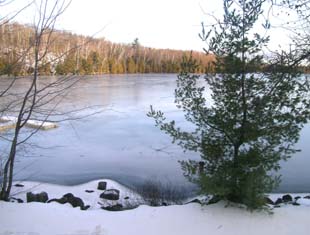
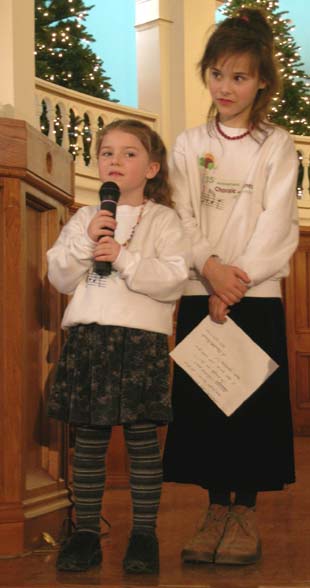
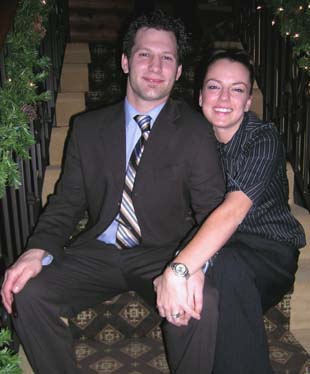
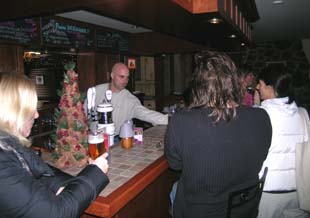
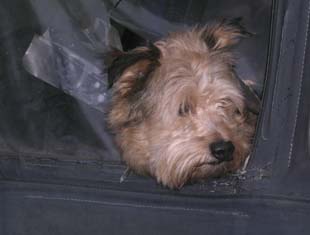
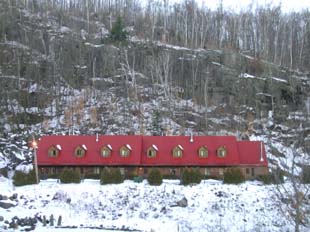
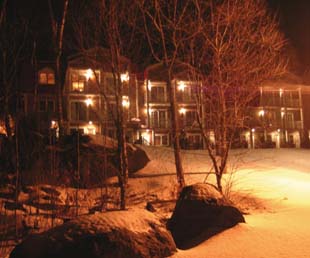
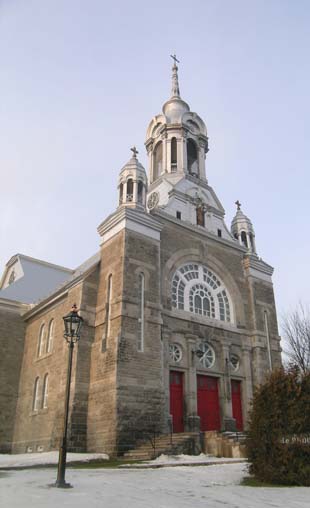
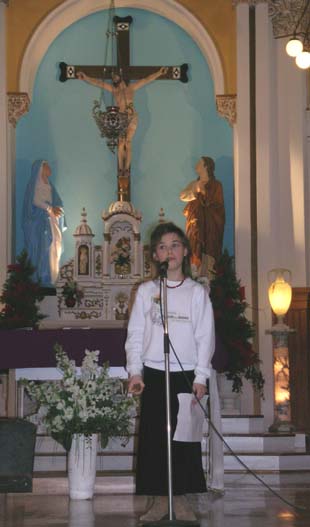
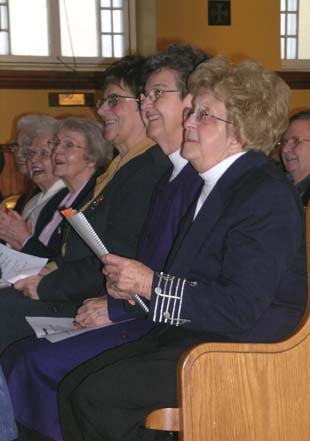
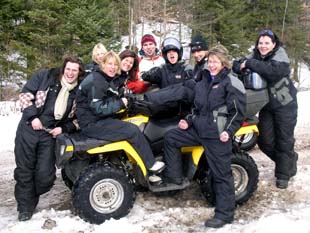
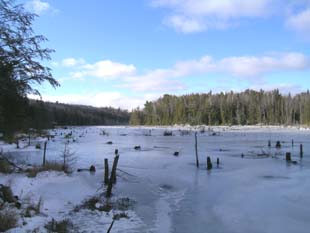
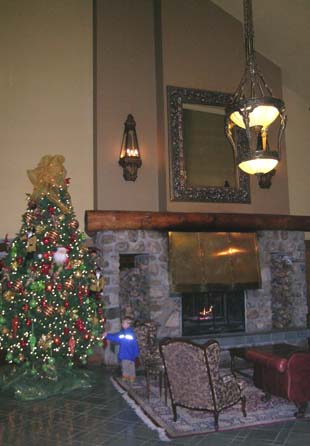
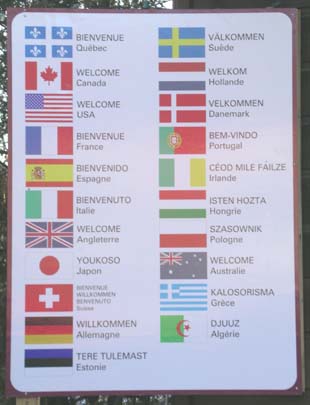
Laurentian Resources
The
Laurentian Tourism Association
info-tourisme@laurentides.com
Toll free number: (Canada and the
U.S.) 1-800-561-6673
L'Auberge
du lac Morency (Resort, Spa, and Conference Centre)
La
Vallée de Saint-Sauveur Tourism
Festival
des Arts de Saint-Sauveur
Ski Mont-Sauveur
Manoir Saint-Sauveur
Resort and Convention Centre
Val-David
Mille
et un pots
Le
Centre d'Exposition de Val-David
The
Dufresne Regional Park
Why the
Laurentians are an enduring experience
This prodigious land and its
physical and cultural landscape are in many ways a microcosm for
the heritage of the Québécois.
The language and culture of
Québec continue to flourish against formidable odds; they
have survived what has been referred to as la marée de
la culture anglophone dans l'Amérique du nord (the tide
of English-speaking culture in North America).
Québec has a total population
of just over seven and a half million people of which 82 per cent
are francophone — whereas the primarily English-speaking culture
of Canada and the United States combined comprises about 145 million
people.
Through persistence and a strong
collective sense of self, this predominantly French-speaking part
of North America is very much alive. And at the heart of the magnificent
and vigorous Laurentians you will experience the self-sustaining
values of the human village — Québécois-style.
Mea Culpa...
but Call me Mr. Cool
As is the case with any major
tourist destination, there are increasingly “issues”
that can create culture clashes. Québec is the traditional
home to the snowmobile (invented by the famous Bombardier company).
Given the terrain, climate, and vast distances of the Laurentides,
it's quite understandable why “skidoos” and all-terrain
vehicles became popular here. However, the movement towards a Laurentians
that is non-moteurisé is picking up speed (pardon
the play on words) and there are communities in the region that
have passed such bylaws. It is a dilemma, especially for me who
prefers a nice quiet canter on my horse, but also is not opposed
to thrills and chills.
But I have to be honest and
tell you that I did the ATV thing — and it was a blast, even
though it meant some initial personal humiliation. Oh, and I plan
to atone for the greenhouse gases I created somehow.
My
great Laurentian ATV experience.
|
















